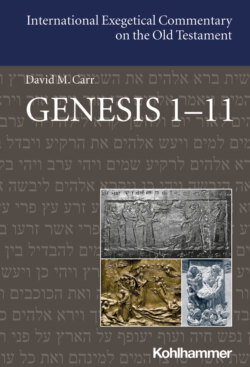Читать книгу Genesis 1-11 - David M. Carr - Страница 11
На сайте Литреса книга снята с продажи.
Ancient Non-Biblical Precursors
ОглавлениеMuch of Gen 1–11 appears to interact with primeval traditions attested in a variety of non-Israelite contexts. Genesis 1, in particular, manifests some potential links to motifs seen in Egyptian contexts. Genesis 6:1–4 features some elements known from Greek, Hittite (originally Hurrian), and Ugaritic texts. In general, however, the texts in Gen 1–11 show the most identifiable connections to texts in the Mesopotamian Sumero-Akkadian literary tradition.
There are several factors that may contribute to the predominance of parallels between Gen 1–11 and Mesopotamian literary texts. To start, we have better access to Mesopotamian literary texts because they were recorded on imperishable clay tablets and sometimes collected in large archives, such as the library of Ashurbanipal. Yet, even beyond such accidents of preservation and collection, the Mesopotamian literary tradition appears to have included an unusually large number of stories about primeval times that are analogous to parts of Gen 1–11. Egyptian scribes seem to have developed relatively few such traditions about primeval times.22 Moreover, most traditions specifically connected to the Levant (e.g., Ugarit) and broader Mediterranean (e.g., Greece) focus on royal-legendary heroic figures rather than the creation of the cosmos and human civilization.23 In connection with Gen 6:1–4, I will mention Hittite-Hurrian myths around Kumarbi and some Greek traditions (especially in Hesiod and Homer) that apparently develop older Near Eastern, Hittite, and Levantine themes about ancient interactions of the gods and humans. Nevertheless, the level of focus on such primeval times is far less in Egypt and Mediterranean scribal spheres than that seen in the Mesopotamian literary tradition, and there is not good evidence for a text in Gen 1–11 specifically responding to a specific text in the Egyptian, Greek, Hittite/Hurrian, or Phoenecian sphere.
Finally, it is important to recognize the multiple occasions in which the Judean scribes might have been exposed to Mesopotamian literary traditions or themes from such traditions. We know that cuneiform texts—specifically including the Adapa and Gilgamesh epics—circulated in the Levant during the Bronze Age, and it is possible that early Judean scribes encountered echoes of those texts in some form, whether preserved versions of some Mesopotamian texts themselves or Canaanite reflections of them.24 When Judah was under Assyrian domination, some elite Judean youths may have been sent to Assyria for education in Assyrian literature, much as happened in other parts of the Assyrian empire.25 Finally, it is possible that the Judean exiles in Babylon encountered and engaged elements of Babylonian literature during their stay there.26
In the end, the argument for textual influence of Mesopotamian or other traditions must be made on a case by case basis. Nevertheless, numerous discussions in the following commentary will provide support to the idea that the character and broader shape of Gen 1–11 were particularly influenced by primeval compositions and cosmogonic traditions seen in Sumero-Akkadian cuneiform literature.
